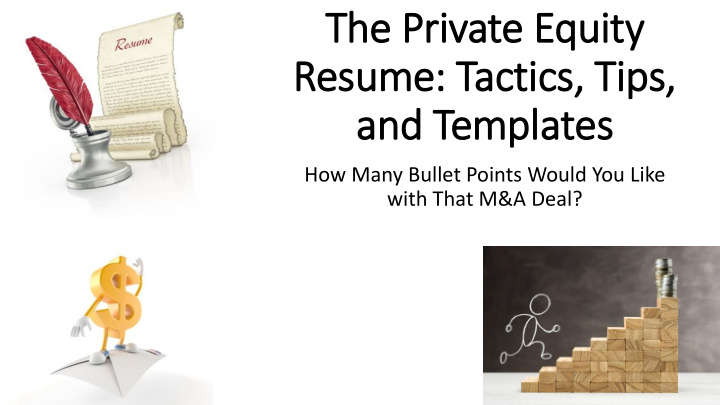



The Private Equity Resume: Tactics, Tips, and Templates How Many Bullet Points Would You Like with That M&A Deal?
Get t the Templates at the Link Below: https://www.mergersandinquisitions.co m/private-equity-resume/ This tutorial is a video version of that article, and we point out a few things on the resume templates that are difficult to illustrate in text.
Why PE Resumes? Isn’t This an Old Topic? • Yes, but the PE recruiting process has changed and become super-accelerated, similar to IB recruiting • Example: At the bulge bracket and elite boutique banks, the on-cycle process might start a month or even weeks after you’ve started working full-time • Result: You’re going to have to spin heavily to turn pitches, potential deals, and ongoing projects into “real deals” • And: If you cannot come up with anything at all, you’ll just have to wait for more deal experience and recruit in a later cycle
The Main in Points That Apply to All PE Resumes • 1 Page Only with 3 Main Sections – Professional Experience on top, then Education, and then Skills & Interests • Work Experience Should Be Most of Your Resume – ~80% of the total, with your current IB/consulting/other role occupying ~50% • Font Face, Size, and Margins – 0.75” margins on each side, size 10-12 font, and Times New Roman, Arial, Calibri, Georgia, etc. • Summary Bullet, Then Deals/Clients/Engagements – Sum up your deals and daily tasks, performance indicators (if any), and then select 2-3 deals/clients/projects to write about
Resume for In Investment Banking Candidates • Why It Matters: Your resume is mostly irrelevant for the on-cycle process at large banks, at least in winning interviews… • But: It’s still important because it forces you to list specific deals, and then you’ll discuss those deals in interviews • So: “Writing your resume” really means, “Selecting your deal experience and practicing discussions of it” • Ideal: 2-3 deals; one deal looks a bit awkward, and if you list 4, 5, or 10 deals, you will not remember everything
Fin inding “Deal Experience” • Picking Priority: Closed or announced deals; canceled or ongoing deals; “client service” engagements; pitches for “potential deals”; and deals from your previous internship(s) • Trick: Especially if you interned at your current bank and then accepted a full-time offer there, you can combine the internship and full-time role into one entry • Too Many Deals: Then prioritize by size (bigger is better, all else being equal) and your individual contributions to the deal process
Writing About Deal l Experience • First: Review the deliverables from your “deals,” including models, presentations, emails, buyer/seller logs, etc., and note the key points: • Transaction Rationale: Why did the buyer/seller want to do the deal or raise capital? What were the approximate financial metrics? • Key Challenges: Price? Financing? Specific investor objection? • Your Contributions: How did you move the deal forward? • Your Opinion of the Deal: Would you have done it? Why / why not?
Writing About Deal l Experience • You’ll then write about those points, except for the last one on your opinion of the deal, on your resume; other tips: • Italicize each deal’s name , with the deal type and approximate amount (round numbers for easier math) • Use company descriptions , not real company names • Use lingo and buzzwords like EBITDA, Enterprise Value, DCF, etc. • Use 2-3 bullets for each deal in the Specifics; Results format
One Final Word of Caution • Do NOT be too aggressive with claims of your “results” or “contributions” • It’s fine to spin pitches into “potential deals,” since there is some truth to that – some pitches do become deals • BUT if you say that you “negotiated” or “increased the purchase price,” or something similar, you will get A LOT of questions on it • Stick to more modest contributions , like finding mistakes in the company’s financials, suggesting new buyers, or finding information that addressed a concern of one buyer or investor
PE Resume for Other Roles… and Consulting • Any deal-based role (smaller bank, corporate development, mezzanine, other PE firm, real estate, etc.) will be similar – but you should, in theory, have more real deal experience to write about • Consulting is tricky because most client engagements tend to focus on operations, not deals or finance • Strategy #1: Spin operational projects by linking them to financial metrics or to the company’s share price, investor reactions, etc. • Strategy #2: Pick projects with direct relevancy, like market sizing in due diligence, M&A integration, expansions or add-ons, etc.
Other Points • Outside Consulting or Deal-Based Roles: You don’t have a good shot at private equity roles – see the M&I articles on PE for more • Undergrads and Recent Grads: Use our university student IB resume template instead, as it’s virtually the same • More Experienced: Devote less and less space to non-PE roles once you’ve been in the industry for a while; after a few years, you may start to need a separate page for Transactions (example)
Recap and Summary • PE Resumes are all about deals, deals, and more deals… well, 2-3 deals, to be more specific • Key Challenge: Spinning pitches/random projects into sounding like deals, going back to your internship(s) if necessary • Sub-Bullets: 2-3 for each deal in Specifics; Results format • Consulting: Spin operational engagements into sounding financial • Finally: Don’t be too aggressive with your “results” claims
Recommend
More recommend